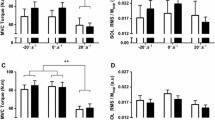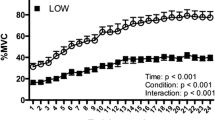Abstract
Purpose
Neuromuscular electrical stimulation (NMES) training is known to induce improvement in force production capacities and fibre-type transition. The aim of this study was to determine whether NMES training also leads to changes in the mechanical properties of the human triceps surae (TS) muscle.
Methods
Fifteen young male subjects performed a training protocol (4 weeks, 18 sessions, 4–5 sessions per week) based on a high-frequency isometric NMES programme of TS muscle. Quick-release test was used to evaluate Musculo-Tendinous (MT) stiffness index (SIMT) as the slope of the linear MT stiffness–torque relationships under submaximal contraction. Sinusoidal perturbations allowed the assessment of musculo-articular stiffness index (SIMA) as well as the calculation of the maximal angular velocity (\(\varTheta_{\hbox{max} }^{{\prime }}\)) of TS muscle using an adaptation of Hill’s equation.
Results
After NMES training, Maximal Voluntary Contraction under isometric conditions and \(\varTheta_{\hbox{max} }^{{\prime }}\) increased significantly by 17.5 and 20.6 %, respectively, while SIMT and SIMA decreased significantly (−12.7 and −9.3 %, respectively).
Conclusions
These changes in contractile and elastic properties may lead to functional changes of particular interest in sport-related activities as well as in the elderly.




Similar content being viewed by others
Abbreviations
- α :
-
Torque constant
- β :
-
Angular velocity constant
- CSA:
-
Cross-sectional area
- K opt :
-
Optimal angular stiffness
- K p :
-
Passive musculo-articular Stiffness
- MHC:
-
Myosin heavy chain
- MVC:
-
Maximal voluntary contraction
- NMES:
-
Neuromuscular electrical stimulation
- \(\varTheta_{\hbox{max} }^{{\prime }}\) :
-
Maximal shortening/angular velocity (for in vivo muscle)
- \(\varTheta_{\text{opt}}^{{\prime }}\) :
-
Optimal shortening/angular velocity
- SEC:
-
Series elastic component
- SIMA :
-
Musculo-articular stiffness index
- SIMT :
-
Musculo-tendinous stiffness index
- T opt :
-
Optimal torque
- V max :
-
Maximal shortening velocity (for isolated muscle)
- \(\omega_{\text{opt}}\) :
-
Optimal angular velocity
References
Allaf O, Goubel F, Marini JF (2002) A curve-fitting procedure to explain changes in muscle force–velocity relationship induced by hyperactivity. J Biomech 35(6):797–802
Almeida-Silveira MI, Pérot C, Pousson M, Goubel F (1994) Effects of stretch-shortening cycle training on mechanical properties and fibre type transition in the rat soleus muscle. Pflugers Arch 427(3–4):289–294
Almeida-Silveira MI, Pérot C, Goubel F (1996) Neuromuscular adaptations in rats trained by muscle stretch–shortening. Eur J Appl Physiol Occup Physiol 72(3):261–266
Aubert X (1956) Structure and physiology of the striated muscle. I. Contractile mechanism in vivo; mechanical and thermal aspects. J Physiol (Paris) 48(2):105–153
Bosco C, Tihanyi J, Komi PV, Fekete G, Apor P (1982) Store and recoil of elastic energy in slow and fast types of human skeletal muscles. Acta Physiol Scand 116(4):343–349. doi:10.1111/j.1748-1716.1982.tb07152.x
Buckwalter JA (1995) Activity vs. rest in the treatment of bone, soft tissue and joint injuries. Iowa Orthop J 15:29–42
Burgess KE, Connick MJ, Graham-Smith P, Pearson SJ (2007) Plyometric vs. isometric training influences on tendon properties and muscle output. J Str Cond Res 21(3):986–989. doi:10.1519/R-20235.1
Caiozzo VJ, Perrine JJ, Edgerton VR (1981) Training-induced alterations of the in vivo force–velocity relationship of human muscle. J Appl Physiol 51(3):750–754
Castaingts V, Martin A, Van Hoecke J, Pérot C (2004) Neuromuscular efficiency of the triceps surae in induced and voluntary contractions: morning and evening evaluations. Chronobiol Int 21(4–5):631–643
Cornu C, Almeida Silveira MI, Goubel F (1997) Influence of plyometric training on the mechanical impedance of the human ankle joint. Eur J Appl Physiol Occup Physiol 76(3):282–288
Desplantez A, Goubel F (2002) In vivo force–velocity relation of human muscle: a modelling from sinusoidal oscillation behaviour. J Biomech 35(12):1565–1573. pii:S0021929002001902
Duchateau J, Hainaut K (1984) Isometric or dynamic training: differential effects on mechanical properties of a human muscle. J Appl Physiol 56(2):296–301
Foure A, Nordez A, Cornu C (2012) Effects of plyometric training on passive stiffness of gastrocnemii muscles and Achilles tendon. Eur J Appl Physiol 112(8):2849–2857. doi:10.1007/s00421-011-2256-x
Gondin J, Guette M, Ballay Y, Martin A (2005) Electromyostimulation training effects on neural drive and muscle architecture. Med Sci Sports Exerc 37(8):1291–1299. pii:00005768-200508000-00006
Gondin J, Brocca L, Bellinzona E, D’Antona G, Maffiuletti NA, Miotti D, Pellegrino MA, Bottinelli R (2011) Neuromuscular electrical stimulation training induces atypical adaptations of the human skeletal muscle phenotype: a functional and proteomic analysis. J Appl Physiol 110(2):433–450
Goubel F, Marini JF (1987) Fibre type transition and stiffness modification of soleus muscle of trained rats. Pflugers Arch 410(3):321–325
Goubel F, Pertuzon E (1973) Evaluation of the elasticity of muscle in situ by the quick-release method. Arch Int Physiol Biochim 81(4):697–707
Gregory CM, Bickel CS (2005) Recruitment patterns in human skeletal muscle during electrical stimulation. Phys Ther 85(4):358–364
Grosset JF, Piscione J, Lambertz D, Pérot C (2009) Paired changes in electromechanical delay and musculo-tendinous stiffness after endurance or plyometric training. Eur J Appl Physiol 105(1):131–139. doi:10.1007/s00421-008-0882-8
Hortobagyi T, Maffiuletti NA (2011) Neural adaptations to electrical stimulation strength training. Eur J Appl Physiol 111(10):2439–2449. doi:10.1007/s00421-011-2012-2
Johns RJ, Wright V (1962) Relative importance of various tissues in joint stiffness. J Appl Physiol 17:824–828
Jubeau M, Sartorio A, Marinone PG, Agosti F, Van Hoecke J, Nosaka K, Maffiuletti NA (2008) Comparison between voluntary and stimulated contractions of the quadriceps femoris for growth hormone response and muscle damage. J Appl Physiol 104(1):75–81. doi:10.1152/japplphysiol.00335.2007
Klein L, Player JS, Heiple KG, Bahniuk E, Goldberg VM (1982) Isotopic evidence for resorption of soft tissues and bone in immobilized dogs. J Bone Jt Surg Amer 64(2):225–230
Kongsgaard M, Reitelseder S, Pedersen TG, Holm L, Aagaard P, Kjaer M, Magnusson SP (2007) Region specific patellar tendon hypertrophy in humans following resistance training. Acta Physiol (Oxf) 191(2):111–121. doi:10.1111/j.1748-1716.2007.01714.x
Kubo K, Kanehisa H, Kawakami Y, Fukunaga T (2000) Elastic properties of muscle–tendon complex in long-distance runners. Eur J Appl Physiol 81(3):181–187. doi:10.1007/s004210050028
Kubo K, Kanehisa H, Ito M, Fukunaga T (2001) Effects of isometric training on the elasticity of human tendon structures in vivo. J Appl Physiol 91(1):26–32
Kubo K, Morimoto M, Komuro T, Yata H, Tsunoda N, Kanehisa H, Fukunaga T (2007) Effects of plyometric and weight training on muscle-tendon complex and jump performance. Med Sci Sports Exerc 39(10):1801–1810. doi:10.1249/mss.0b013e31813e630a
Lambertz D, Pérot C, Kaspranski R, Goubel F (2001) Effects of long-term spaceflight on mechanical properties of muscles in humans. J Appl Physiol 90(1):179–188
Maffiuletti NA, Pensini M, Martin A (2002) Activation of human plantar flexor muscles increases after electromyostimulation training. J Appl Physiol 92(4):1383–1392. doi:10.1152/japplphysiol.00884.2001
Maffiuletti NA, Zory R, Miotti D, Pellegrino MA, Jubeau M, Bottinelli R (2006) Neuromuscular adaptations to electrostimulation resistance training. Am J Phys Med Rehabil 85(2):167–175. pii:00002060-200602000-00011
Martin A, Carpentier A, Guissard N, van Hoecke J, Duchateau J (1999) Effect of time of day on force variation in a human muscle. Muscle Nerve 22(10):1380–1387. doi:10.1002/(SICI)1097-4598(199910)22:10<1380:AID-MUS7>3.0.CO;2-U
Minetto MA, Botter A, Bottinelli O, Miotti D, Bottinelli R, D’Antona G (2013) Variability in muscle adaptation to electrical stimulation. Int J Sports Med 34(6):544–553. doi:10.1055/s-0032-1321799
Noyes FR (1977) Functional properties of knee ligaments and alterations induced by immobilization: a correlative biomechanical and histological study in primates. Clin Orthop Relat Res 123:210–242
Ochala J, Lambertz D, Pousson M, Goubel F, Hoecke JV (2004) Changes in mechanical properties of human plantar flexor muscles in ageing. Exp Gerontol 39(3):349–358. doi:10.1016/j.exger.2003.11.004
Perez M, Lucia A, Rivero JL, Serrano AL, Calbet JA, Delgado MA, Chicharro JL (2002) Effects of transcutaneous short-term electrical stimulation on M. vastus lateralis characteristics of healthy young men. Pflugers Arch 443(5–6):866–874. doi:10.1007/s00424-001-0769-6
Petit J, Filippi GM, Gioux M, Hunt CC, Laporte Y (1990) Effects of tetanic contraction of motor units of similar type on the initial stiffness to ramp stretch of the cat peroneus longus muscle. J Neurophysiol 64(6):1724–1732
Pousson M, Perot C, Goubel F (1991) Stiffness changes and fibre type transitions in rat soleus muscle produced by jumping training. Pflugers Arch 419(2):127–130
Reiser PJ, Moss RL, Giulian GG, Greaser ML (1985) Shortening velocity and myosin heavy chains of developing rabbit muscle fibers. J Biol Chem 260(27):14403–14405
Simoneau JA, Lortie G, Boulay MR, Marcotte M, Thibault MC, Bouchard C (1985) Human skeletal muscle fiber type alteration with high-intensity intermittent training. Eur J Appl Physiol Occup Physiol 54(3):250–253
Suetta C, Andersen JL, Dalgas U, Berget J, Koskinen S, Aagaard P, Magnusson SP, Kjaer M (2008) Resistance training induces qualitative changes in muscle morphology, muscle architecture, and muscle function in elderly postoperative patients. J Appl Physiol 105(1):180–186. doi:10.1152/japplphysiol.01354.2007
Thorstensson A, Grimby G, Karlsson J (1976) Force-velocity relations and fiber composition in human knee extensor muscles. J Appl Physiol 40(1):12–16
Tipton CM, Matthes RD, Maynard JA, Carey RA (1975) The influence of physical activity on ligaments and tendons. Med Sci Spor 7(3):165–175
Tognella F, Mainar A, Vanhoutte C, Goubel F (1997) A mechanical device for studying mechanical properties of human muscles in vivo. J Biomech 30(10):1077–1080. pii:S0021929097000675
Vaz MA, Baroni BM, Geremia JM, Lanferdini FJ, Mayer A, Arampatzis A, Herzog W (2013) Neuromuscular electrical stimulation (NMES) reduces structural and functional losses of quadriceps muscle and improves health status in patients with knee osteoarthritis. J Orthop Res 31(4):511–516. doi:10.1002/jor.22264
Woo SL, Gomez MA, Woo YK, Akeson WH (1982) Mechanical properties of tendons and ligaments. II. The relationships of immobilization and exercise on tissue remodeling. Biorheology 19(3):397–408
Wright V, Johns RJ (1960) Observations on the measurement of joint stiffness. Arthr Rheum 3:328–340
Acknowledgments
The authors are indebted to the subjects who kindly participated in the study. The authors also thank Compex Company for technical support in this study.
Author information
Authors and Affiliations
Corresponding author
Additional information
Communicated by Olivier Seynnes.
Rights and permissions
About this article
Cite this article
Grosset, JF., Canon, F., Pérot, C. et al. Changes in contractile and elastic properties of the triceps surae muscle induced by neuromuscular electrical stimulation training. Eur J Appl Physiol 114, 1403–1411 (2014). https://doi.org/10.1007/s00421-014-2871-4
Received:
Accepted:
Published:
Issue Date:
DOI: https://doi.org/10.1007/s00421-014-2871-4




